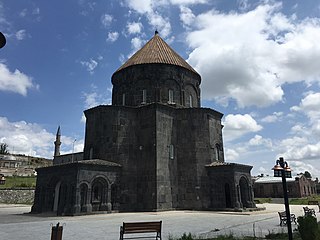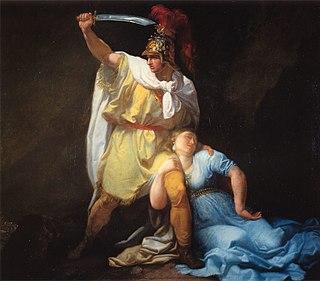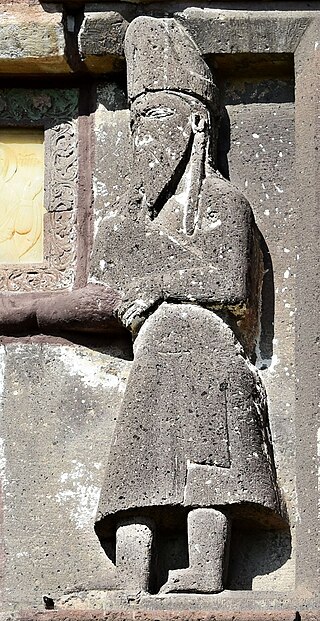
Tamar the Great reigned as the Queen of Georgia from 1184 to 1213, presiding over the apex of the Georgian Golden Age. A member of the Bagrationi dynasty, her position as the first woman to rule Georgia in her own right was emphasized by the title mepe ("king"), afforded to Tamar in the medieval Georgian sources.

Kars is a city in northeast Turkey. It is the seat of Kars Province and Kars District. As of 2022, its population was 91,450. Kars, in classical historiography (Strabo), was in the ancient region known as Chorzene, part of the province of Ayrarat in the Kingdom of Armenia, and later the capital of the Bagratid Kingdom of Armenia from 929 to 961. Currently, the mayor of Kars is Türker Öksüz. The city had an Armenian ethnic majority until it was re-captured by Turkish nationalist forces in late 1920.

George IV, also known as Lasha Giorgi (1191–1223), of the Bagrationi dynasty, was a king (mepe) of Georgia from 1213 to 1223.

The Battle of Basiani was fought between the armies of the Kingdom of Georgia and the Seljukid Sultanate of Rum in the Basiani Valley, 60 km north-east of the city of Erzurum in what is now northeast Turkey. The date of the battle has been debated, but recent scholarship tends to favor the years 1203 or 1204. According to modern Turkish historians, the site of the battle is usually identified as the castle of Micingerd (Mazankert).

Demetrius I, from the Bagrationi dynasty, was King (mepe) of Georgia from 1125 to 1156. He is also known as a poet. He was King of Georgian kingdom two times, first in 1125 to 1154 and second in 1155 before his death in 1156.

The Shaddadids were a Kurdish Sunni Muslim dynasty. who ruled in various parts of Armenia and Arran from 951 to 1199 AD. They were established in Dvin. Through their long tenure in Armenia, they often intermarried with the Bagratuni royal family of Armenia.

The Ildegizids, Eldiguzids or Ildenizids, also known as Atabegs of Azerbaijan were an Atabegate of the Seljuk Empire, and a Sunni Muslim Turkic dynasty, which controlled most of northwestern Persia, eastern Transcaucasia, including Arran, most of Azerbaijan, and Djibal. At their maximum extent, the territory under their control, roughly corresponds to most of north-western Iran, most of the regions of modern Azerbaijan and smaller portions in modern Armenia, Turkey and Iraq. Down to the death in war 1194 of Toghril b. Arslan, last of the Great Seljuq rulers of Iraq and Persia, the Ildenizids ruled as theoretical subordinates of the Sultans, acknowledging this dependence on their coins almost down to the end of the Seljuqs. Thereafter, they were in effect an independent dynasty, until the westward expansion of the Mongols and the Khwarazm-Shahs weakened and then brought the line to its close.

The Kingdom of Georgia, also known as the Georgian Empire, was a medieval Eurasian monarchy that was founded in c. 1008 AD. It reached its Golden Age of political and economic strength during the reign of King David IV and Queen Tamar the Great from the 11th to 13th centuries. Georgia became one of the pre-eminent nations of the Christian East, and its pan-Caucasian empire and network of tributaries stretched from Eastern Europe to Anatolia and northern frontiers of Iran, while Georgia also maintained religious possessions abroad, such as the Monastery of the Cross in Jerusalem and the Monastery of Iviron in Greece. It is the principal historical precursor of present-day Georgia.

The Iberian–Armenian War was a war for the throne of Armenia between the Kingdom of Iberia and the Armenian Arsacids. It is known chiefly through its description in Tacitus 'Annals.

The Zakarid dynasty, also Zakarids or Zakarians were a noble Armenian dynasty, rulers of Zakarid Armenia (1201–1350) under the suzerainty of the Kingdom of Georgia, and from 1256 under the control of the Mongol Ilkhanate of Persia. Their dynastic name was formed in honour of Zakare, the famous servant of the Georgian Queen Tamar. They were also known by their Georgian nickname Mkhargrdzeli. A family legend says that this name was a reference to their Achaemenid ancestor Artaxerxes II the "Longarmed". According to Cyril Toumanoff / Encyclopædia Iranica, they were an offshoot of the Armenian Pahlavuni family. The Zakarians considered themselves Armenians.
The Sukhumi riot was a riot in Sukhumi, Abkhaz Autonomous Soviet Socialist Republic, Georgian Soviet Socialist Republic, Soviet Union, in July 1989, triggered by an increasing inter-ethnic tensions between the Abkhaz and Georgian communities and followed by several days of street fighting and civil unrest in Sukhumi and throughout Abkhazia.

Mariam, was a Georgian queen and regent. She was the daughter of John-Senekerim Artsruni, an Armenian king of Vaspurakan, and the first consort of the king George I of Georgia. As a dowager queen of Georgia, she ruled as regent for her underage son, Bagrat IV, from 1027 to 1037, and was involved in diplomacy with the Byzantine Empire.

The Timurid invasions of Georgia were eight invasions between 1386 and 1403 of the Kingdom of Georgia in the Caucasus by the Timurid Empire. Led by Timur, the Timurids ultimately conquered the Christian monarchy and made it a tributary state that kept its independence and religion.

Zakarid Armenia alternatively known as the Zakarid Period, describes a historical period in the Middle Ages during which the Armenian vassals of the Kingdom of Georgia were ruled by the Zakarid-Mkhargrzeli dynasty. The city of Ani was the capital of the princedom. The Zakarids were vassals to the Bagrationi dynasty in Georgia, but frequently acted independently and at times titled themselves as kings. In 1236, they fell under the rule of the Mongol Empire as a vassal state with local autonomy.

The Georgian–Seljuk wars, also known as Georgian Crusade, is a long series of battles and military clashes that took place from c. 1048 until 1213, between the Kingdom of Georgia and the different Seljuqid states that occupied most of Transcaucasia. The conflict is preceded by deadly raids in the Caucasus by the Turks in the 11th century, known in Georgian historiography as the Great Turkish Invasion.

Zakare II Zakarian or Zakaria II Mkhargrdzeli, was an Armenian prince and a Court official of the Kingdom of Georgia holding the office of amirspasalar (Commander-in-Chief) of the Georgian army for Queen Tamar of Georgia, during the late 12th and early 13th centuries. He was a member of the Zakarid dynasty, and ruler of feudal lands in the Kingdom of Georgia.

Ivane I Zakarian was an Armenian prince, and a Court official of the Kingdom of Georgia holding the offices of Msakhurtukhutsesi (Majordomo) and Atabeg for Queen Tamar of Georgia during the early 13th centuries. He was a prince of the Zakarid dynasty, the son of Sargis Zakarian, and the younger brother and successor of Zakare II Zakarian. He was also ruler of feudal lands in the Kingdom of Georgia.
Ivane II Orbeli was a Court official of the Kingdom of Georgia, holding the offices of Amirspasalar (Commander-in-Chief) and Mandaturtukhutsesi.















